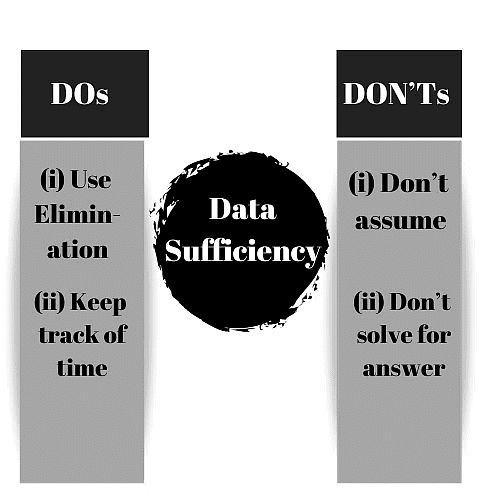Introduction: Data Sufficiency | CSAT Preparation - UPSC PDF Download
| Table of contents |

|
| What is Data Sufficiency |

|
| Approaching Data Sufficiency Questions |

|
| How to Solve Data Sufficiency Questions |

|
| Types of Data Sufficiency |

|
| Solved Examples |

|
Data Sufficiency questions introduce a distinct challenge compared to standard problem-solving tasks. They not only evaluate your subject knowledge but also test your ability to determine whether the given information is sufficient to arrive at a solution. Essentially, these questions assess your skills in logical reasoning and critical thinking.
What is Data Sufficiency
In Data Sufficiency, you need to figure out whether or not the data given in the question / statements is good enough to find out a unique answer.
Is the data enough to find out a unique answer?
Please note that in Data Sufficiency:
- You do not need to find out the answer
- You need to find out whether or not you can find out the answer

A Data Sufficiency question set will contain the following:
• Instructions – they may vary set per set
• Questions (with or without data)
• Two statements (with data – may or may not be sufficient)
Data Sufficiency questions typically consist of two statements accompanied by the following four options:
(A) Both statements together are sufficient to answer the question
(B) Only one of the statements alone is sufficient to answer the question but not the other.
(C) Each of the statements alone can answer the question
(D) Both the statements together are not sufficient to answer the question.
Example:
What is the value of ‘x’?
Statement A: x < 10
Statement B: x > 8
By combining both statements, I can say that x lies between 8 and 10. The only integer between 8 and 10 is 9. So my answer should be Option 3
WRONG!
Nowhere in the question it is mentioned that x is an integer / natural number. Until and unless that is specified, we cannot uniquely determine the value of ‘x’. It can take any value from 8 to 10 {eg: 8.1, 8,2, 9.999, etc.}
So, the correct answer would be Option 4
Statement A: 3x + 7y = 10
Statement B: 2x + 9y = 8
Approaching Data Sufficiency Questions
- When tackling Data Sufficiency questions, it's important to keep in mind that the objective is to decide if the information given in the statements is enough or not. The goal isn't to solve the problem entirely, but rather to pinpoint what information is lacking.
- To start, carefully read the question and statements, and identify the information needed to answer the question. Predict what details might be present in each statement. Then, assess each statement independently to determine if it furnishes sufficient information. Lastly, assess both statements together to ascertain if the combined information is enough to answer the question.
- Keep in mind that Data Sufficiency questions are crafted to be tricky, so refrain from making assumptions or hasty conclusions. Rely on logical reasoning and critical thinking to assess the provided information and figure out what additional details are required to answer the question.

How to Solve Data Sufficiency Questions
1. Understand the Question Statement
- Before examining the answer choices, it is essential to thoroughly read and understand the question stem in Data Sufficiency questions. These questions are designed to test your ability to determine whether the given information is adequate to solve the problem, rather than finding the actual solution.
- An effective strategy for tackling these questions involves planning before diving into the solution.
- Break down the question into smaller components and strive to grasp the essence of what is being inquired.
2. Use the process of elimination
- If required, you can randomly select an answer from the remaining ones after eliminating some options. Eliminating a couple of options greatly increases the probability of getting the answer right.
- Let’s consider an example:
Question: How old will Jagan be on Jan 1st 2015?
Statement 1: Jagan is two years younger than Lokesh and both their ages are prime numbers on Jan 1st 2013.
Statement 2: Jagan’s age was a prime number on Jan 1st 2011.
A) Both statements together are sufficient to answer the question
B) Only one of the statements alone is sufficient to answer the question but not the other.
C) Each of the statements alone can answer the question
D) Both the statements together are not sufficient to answer the question.
The question can’t be answered by using only one of the two Statements given. We can thus eliminate (B) and (C) even before doing the rest of the calculations, we can conclude the answer is either (A) or (D).
Using both the statements together, if Jagan is aged x in 2013, we can conclude that x-2, x and x+2 are prime.
This is true only for the set {3, 5, 7}.
So, x is 5 and Jagan will be aged 7 on Jan 1st 2015.
 |
Download the notes
Introduction: Data Sufficiency
|
Download as PDF |
3. Don’t assume things that aren’t mentioned.
- Candidates frequently make the mistake of assuming such as all numbers are positive or incorrectly assuming that a chord represents the diameter of a circle. Such assumptions can result in incorrect answers, and these errors come with a twofold consequence for the student's performance.
- Firstly, wrong answers lead to negative marks.
- Secondly, valuable time is squandered on erroneous calculations.
Types of Data Sufficiency
As of now we know what consists of the questions related to the Data Sufficiency reasoning section. Let us see the various types of Data Sufficiency one by one from below.
1. Blood Relation
In this type of data sufficiency, relation between 2 people will be asked and candidates need to find the statement(s) in which data is sufficient to find the relation or the correct answer.
2. Order & Ranking
In this type of data sufficiency, data on order of people or their ranking will be provided and candidates will need to find statement(s) in which data is sufficient to find the correct answer.
3. Direction & Distance
In this type of data sufficiency, data on direction of people or points and the distance traveled by a person or distance between the points will be given and candidates will need to find the statement(s) in which data is sufficient to find the direction or distance between the points. 
4. Coding Decoding
In this type of data sufficiency, words or letters will be coded and candidates will need to find the statement(s) in which data is sufficient to find the logic applied to decide the code.
5. Seating Arrangement
In this type of data sufficiency, data on arrangement of people will be provided and candidates will need to find the statement(s) in which data is sufficient to find the correct answer. Seating Arrangements are of two types such as Linear Arrangement and Circular Arrangement. In Linear Arrangement, people will be arranged or seated in one or multiple rows. In Circular Arrangement, people will be arranged or seated around a circular table.
6. Floor Puzzle
In this type of data sufficiency, data on people living on different floors of either same or different buildings will be given and candidates will need to find the statement(s) in which data is sufficient to find the correct answer.
7. Scheduling
In this type of data sufficiency, data based on months, years or date will be given and candidates need to decide whether the data provided in the statements is sufficient or not.
Solved Examples
Q1: What is the value of X*Y?
Statement 1: HCF of X and Y is 3
Statement 2: LCM of X and Y is 36
(A) The question can be answered using one of the statements alone and not by using the other statement
(B) The question can be answered using either of the statements alone.
(C) The question can't be answered by either of the statements alone, but can be answered by using both
(D) The question can't be answered by using both the statements together.
Ans: (C)
Sol:
Using either of the two statements alone, we can't calculate the value of X*Y.
Using both the statements together, we can conclude that the product of two numbers equals the product of its HCF and LCM = 108
Q2: Priya went to a candy shop to buy some caramel pops, toffee bites and mango pops. What is the total price of one caramel pop, one mango pop and one toffee bite?
Statement 1: The cost of three caramel pops, five toffee bites and seven mango pops is Rs 68
Statement 2: The cost of two caramel pops, three toffee bites and four mango pops is Rs 41
(A) The question can be answered using one of the statements alone and not by using the other statement
(B) The question can be answered using either of the statements alone.
(C) The question can't be answered by either of the statements alone, but can be answered by using both
(D) The question can't be answered by using both the statements together.
Ans: (C)
Sol:
Let the cost of caramel, toffee and mango be x, y and z.
Using Statement 1: 3x+5y+7z=68.
Using Statement 2: 2x+3y+4z=41.
We cannot determine an answer from either of the two statements alone.
Using both statements and multiplying the second equation by 2 and subtracting the first equation from it, we get
(4x+6y+8z)-(3x+5y+7z)=2*41-68=14.
or x+y+z=14
So, we can answer the question using both Statements together, but not by using any of the two statements individually.
Q3: What is Glory's age ?
I. Glory, Vijay and Katie are all of the similar age.
II. Total age of Vijay, Katie and Arica is 32 and Arica is as old as Vijay and Katie together.
(A) If the data in Statement I is alone sufficient to answer the question
(B) If the data in Statement II is alone sufficient to answer the question
(C) If the data in Statement I or Statement II alone is sufficient to answer the question
(D) If the data in both the statements together is needed
Ans: (D)
Sol:
As given in statements I and II, we have Glory = Vijay = Katie, Vijay + Katie + Arica = 32 and Arica = Vijay + Katie.
Putting Vijay + Katie = Arica in second. we get 2Arica = 32 or Arica = 16.
Thus, Vijay + Katie = 16 and Vijay = Katie. So, Vijay = Katie = 8. Thus, Glory = 8. Hence, both the statements are needed.
Q4: In a certain code language, ‘23’ means ‘No More and ‘79’ means ‘harmful thing’. What is the meaning of ‘9’ and ‘7’ respectively in that code?
I. ‘274’ means ‘no bad thing’
II. ‘839’ means ‘more is harmful’.
(A) If the data in Statement I is alone sufficient to answer the question
(B) If the data in Statement II is alone sufficient to answer the question
(C) If the data in Statement I or Statement II alone is sufficient to answer the question
(D) If the data in both the statements together is needed
Ans: (B)
Sol:
‘79’ means ‘harmful thing’ and ‘274’ means ‘no bad thing’. Hence common letter ‘7’ denotes ‘thing’. Hence ‘9’ is obviously ‘harmful’. So I alone can be sufficient. Also, ‘79’ is ‘harmful thing’ and ‘839’ is ‘more is harmful’ from which it can be implied that ‘9’ is ‘harmful’. Hence II alone can also be sufficient. Hence either I or II alone can be sufficient.
Q5: Zuber, Krishna, and Amrish invested in a business and agreed to share the profit in the ratio of their investments. In what proportion will they share the profit?
I. Zuber invested ₹80,000 in the business.
II. Krishna and Amrish together invested a total of ₹1,20,000, and Amrish’s investment was twice that of Krishna’s.
(A) If the data in Statement I is alone sufficient to answer the question
(B) If the data in Statement II is alone sufficient to answer the question
(C) If the data in Statement I or Statement II alone is sufficient to answer the question
(D) If the data in both the statements together is needed
Ans: (D)
Sol:
Statement I gives the amount Zuber invested but provides no information about Krishna or Amrish’s individual investments.
Statement II tells us the total investment made by Krishna and Amrish, and their internal ratio, but we still don't know how much Zuber invested.
Only when both statements are combined can we get the individual investments of all three and thus determine the profit-sharing ratio.
Hence, both statements together are required.
Q6: In an innings of a T20 international match six batsman, Raina, Yuvraj, Kohli, Dhoni, Rahane and Dhawan have scored different number of runs. How many batsmen have scored more runs than Dhoni?
(I) Rahane has scored 7 runs less than Yuvraj and 10 runs more than Raina.
(II) Kohli has scored 56 runs, which is 8 runs less than Dhoni.
(III) Raina has scored 34, which is 1 run less than Dhawan.
(A) If the data in Statement I alone is sufficient to answer the question
(B) If the data in Statement II alone is sufficient to answer the question
(C) If the data in Statement III alone is sufficient to answer the question
(D) If the data in all the statements I, II, and III together are required to answer the question
Ans: (D)
Sol: If we analyze the given statements then we get,
(a) Raina has scored 34, which is 1 run less than Dhawan, which means Dhawan has scored 35.
(b) Kohli has scored 56 runs, which is 8 runs less than Dhoni, which means the score of Dhoni is 64.
(c) Rahane has scored 7 runs less than Yuvraj and 10 runs more than Raina, which means Rahane scored 10+34 = 44 and Yuvraj scored 44+7 = 51.
As we can see, no one has scored more than Dhoni and all the statements were required to get the final answer.
Q7: If City A and City E are in a straight line and the distance between A and C is the equal in distance between F and E then find out City A is in which direction with respect to City E.
(I) A is the north of F, which is to the west of C
(II) A is to the north west of C
(III) E is to the north west of F
(A) If the data in Statement I alone is sufficient to answer the question
(B) If the data in Statement II alone is sufficient to answer the question
(C) If the data in Statement I and III together are sufficient to answer the question
(D) If the data in all the statements together are required to answer the question
Ans: (C)
Sol: From Statement I: F is west of C, and A is north of F
From Statement III: E is northwest of F
Combining I and III helps us visualize the full directional setup and determine A’s position relative to E.
Hence, I and III together are sufficient.
Q8: In a certain code, “14” means “stop whispering” and “68” means “its irritating”. What do 8 and 6 mean respectively in that code?
(I) 167 means “stop irritating me”
(II) 4982 means “it’s sound like whispering”
(A) If the data in Statement I alone is sufficient to answer the question
(B) If the data in Statement II alone is sufficient to answer the question
(C) If the data in Statement I or Statement II alone is sufficient to answer the question
(D) If the data in both the statements together are required to answer the question
Ans: (C)
Sol:
Given:
14 = stop whispering
68 = its irritating
Now in statement 1, 167 “stop irritating me”, where 1 is stop, 6 is “irritating”, so 6 means “irritating” and 8 means “it’s” we can easily find the final answer from statement I.
Now in statement 2, 4982 means “it’s sound like whispering” so 4 means “whispering”, and 8 means “it’s” so we can say that 6 means “irritating” and 8 means “it’s”. We can also very easily final the final answer from Statement II.
Therefore, both Statement I and II are sufficient.
Q9: How is Vivaan related to Yeshna?
(I) Vivaan is the only son of Yeshna’s mother-in-law
(II) Neelam is Vivian’s only sister.
(A) If the data in Statement I alone is sufficient to answer the question
(B) If the data in Statement II alone is sufficient to answer the question
(C) If the data in Statement I or Statement II alone is sufficient to answer the question
(D) If the data in both the statements together are required to answer the question
Ans: (A)
Sol: Statement I: Vivaan is the only son of Yeshna’s mother-in-law → implies Vivaan is Yeshna’s husband
Statement II: Neelam is Vivaan’s sister → doesn’t help with relation to Yeshna
So, only I is sufficient.
Q10: Four friends – P, Q, R, and S – are playing a game of cards. They are sitting at the corners of a square table, facing the center, and each is paired with one partner. Who is R’s partner?
I. P is sitting opposite to S.
II. Q is sitting to the immediate right of P and to the immediate left of S.
(A) If the data in Statement I alone is sufficient to answer the question
(B) If the data in Statement II alone is sufficient to answer the question
(C) If the data in Statement I or Statement II alone is sufficient to answer the question
(D) If the data in both the statements together are required to answer the question
Ans: (D)
Sol: Statement I tells us who is sitting opposite whom (P opposite S) but doesn't give information about R.
Statement II provides relative positions among Q, P, and S, but again, R's partner is not directly mentioned.
Only when both statements are combined can we determine the complete seating arrangement and thereby find out R’s partner.
Hence, both statements together are required.
|
209 videos|138 docs|138 tests
|
FAQs on Introduction: Data Sufficiency - CSAT Preparation - UPSC
| 1. What is Data Sufficiency in quantitative reasoning? |  |
| 2. How should I approach Data Sufficiency questions during an exam? |  |
| 3. What are the types of Data Sufficiency questions? |  |
| 4. What strategies can help improve my performance on Data Sufficiency questions? |  |
| 5. Can you provide an example of a Data Sufficiency question and its solution? |  |


























